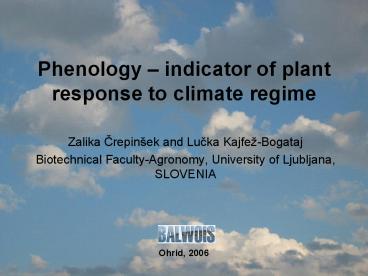Phenology - PowerPoint PPT Presentation
1 / 13
Title:
Phenology
Description:
Six different phenophases and 17 plants were chosen to represent FOUR GROUPS of ... The correlation between winter North Atlantic Oscillation Index (NAOIwin) and ... – PowerPoint PPT presentation
Number of Views:1109
Avg rating:3.0/5.0
Title: Phenology
1
Phenology indicator of plant response to
climate regime
- Zalika Crepinšek and Lucka Kajfež-Bogataj
- Biotechnical Faculty-Agronomy, University of
Ljubljana, SLOVENIA
Ohrid, 2006
2
PHENOLOGY is the study of the TIMING OF
RECURRING BIOLOGICAL PHASES, the CAUSES of their
timing with regard to BIOTIC and ABIOTIC FORCES,
and the INTERRELATIONS among phases of the same
or different species (Lieth, 1997)
3
The aim of our study was to - EXPLAIN WEATHER
VARIABILITY EFFECT ON PHENOLOGY - WORKING OUT
STATISTICAL MODELS that are able TO PREDICT LEAF
UNFOLDING AND FLOWERING DATES of differents
plants
Early FORECASTING of the PHENOLOGICAL PHASES of
WILD and CULTIVATED PLANTS is of great SUPPORT to
VARIOUS SECTORS OF HUMAN ACTIVITY, particulary
for all agricultural practices.
4
MATERIALS AND METHODS
- PHENOLOGICAL and CLIMATE DATA were provided by
- ENVIRONMENTAL AGENCY OF THE REPUBLIC OF SLOVENIA
(ARSO) for the period 1955-2000 for 8 locations
in Slovenia
Six different phenophases and 17 plants were
chosen to represent FOUR GROUPS of phenological
objects WILD HERBACEOUS PLANTS FOREST TREES AND
SHRUBS GRASSES FRUIT TREES
5
STUDIED PHENOPHASES
LEAF UNFOLDING, NEEDLE EMERGENCE
BEGINNING OF FLOWERING, FULL FLOWERING
AUTUMNAL LEAF COLOURING
FIRST RIPE FRUITS, MATURITY
6
(No Transcript)
7
- MULTIPLE LINEAR REGRESSION (Storch and Zwiers,
1999) was used to relate the occurrence dates of
selected phenophases (predictand) with
meteorological variables and previously observed
occurrence dates of phenophases of other plants
(predictors) (stepwise selection) - We
tested models with CROSS VALIDATION METHOD, also
on independent data set for year 2000
PREDICTANDS were beginning of flowering of
apple tree, plum tree, dandelion, cocks-foot,
common silver birch and large-leaved lime, full
flowering of apple tree, plum tree, hazel, black
locust and common elder, first leaf unfolding of
beech, common silver birch and large-leaved lime.
GROWING DEGREE DAYS (GDD) (McMaster and Wilhelm,
1997) BASE TEMPERATURES (Tb) were calculated
with - THE SMALLEST STANDARD DEVIATION OF
GDD method (Yang et al., 1995) PHOTOTHERMAL
TIME (PT) (Masle et al. (1989)
8
RESULTS
- The average defined correlation coefficients
between flowering dates and mean monthly air
temperatures were strong and negative, from 0.6
to 0.85 on the average values for leaf
unfolding phases were a little lower. - Correlation was weaker and positive for autumnal
phases, which means higher temperatures delay the
end of growing season. - In most cases both flowering and leaf unfolding
were accelerated by 3-5 days per 1C increase in
mean monthly or bimonthly temperature from the
starting date.
9
Correlation between full flowering of hazel
(F2Hazel) and the average temperature from
January to February in Ljubljana, 1955-2000. The
correlation coefficient of r - 0.86 is
significant with Plt0.001. DOY day of the
year
10
- The correlation between winter North Atlantic
Oscillation Index (NAOIwin) and temperature was
highly significant for all stations for the
months from December to March, the average
correlation coefficient was 0.58. - With NAOIwin variability we explained the large
part of variation in flowering phases of
early-spring plants like dandelion, pussy willow
and hazel - Correlations were weaker for late-spring
phenophases and no correlations were found for
autumn phenological phases
11
Inversely-proportionality of curves of full
flowering of hazel (F2 Hazel) and winter North
Atlantic Oscillation Index (NAOIwin) in Ratece,
1956-1999. The correlation coefficient of r -
0.63 is significant with Plt0.05. DOY day of
the year.
The amount of monthly precipitation in concrete
conditions was NOT significantly correlated to
date of flowering and leaf unfolding, although it
could be of importance in extremely dry years, IN
SPRING TIME THE WATER IN SLOVENIA IS USUALLY NOT
LIMITATION FOR PLANT DEVELOPMENT
12
Example of PHENOCLIMATIC MODEL- Beginning of
flowering of dandelion
PREDICTORS PHENOLOGICAL AND CLIMATOLOGICAL DATA
Precipitations and NAOI were included in smaller
number of models. Comparatively small part of the
whole variability can be explained by those two
independent variables. This may be also a result
of intercorrelations between TEMPERATURE, NAO and
precipitations. In phenoclimatic modelling, the
GDD and mean monthly temperatures appeared to be
the best parameters, although the coefficient of
determination increased when the other variables
(precipitations, PT, NAOI) were taken into
account
13
CONCLUSIONS
- - PHENOCLIMATIC MODELS showed TEMPERATURE and its
derivatives to be THE MAJOR DRIVING FORCE for the
onset of leaf unfolding and flowering - - Different thresholds temperatures have been
selected for different LOCATIONS for computing
GDD, the SAME SPECIES in DIFFERENT LOCATIONS
showed ADAPTATION to different environmental
conditions - (GDD were lower in colder locations for the same
plant) - - Considering the high year-to-year variability
of phenological events, the models presented
provide SATISFACTORY ESTIMATIONS of the leaf
unfolding and flowering dates - and could be
powerfully EXTENDED AND APPLIED TO OTHER SITES
AND PLANTS, if sufficiently LONG TIME SERIES OF
DATA are available.































